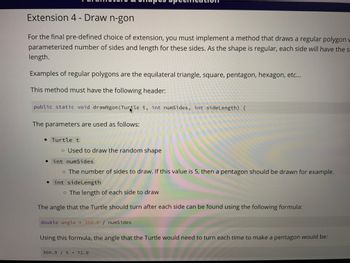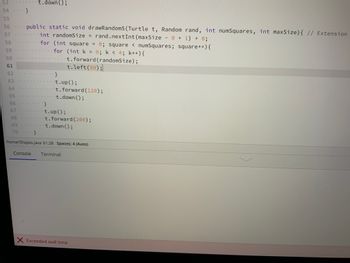
Use java
See the image for requirements

Trending nowThis is a popular solution!
Step by stepSolved in 2 steps

Thanks you so much!
Another questions: this is my code (see image), and I was trying to let the turtle to draw 4 different sizes sqaures, but after I ran my code, the turtle drew out 4 same size squares, where or how should I fix it(or update it)?
thank you.

Can you provide a screenshot? It's a little bit hard to read like this
thank you
Thank you. But can you use the parameters and the formula given in the image??
Thanks you so much!
Another questions: this is my code (see image), and I was trying to let the turtle to draw 4 different sizes sqaures, but after I ran my code, the turtle drew out 4 same size squares, where or how should I fix it(or update it)?
thank you.

Can you provide a screenshot? It's a little bit hard to read like this
thank you
Thank you. But can you use the parameters and the formula given in the image??
- Provide directional explanations for the design flaws. Most pointers in programming languages can only refer to one particular sort of variable.arrow_forwardWhat exactly is meant by the phrase "user-defined data types"?arrow_forwardFor whatever reason, a data object is not included in the data model.arrow_forward
 Database System ConceptsComputer ScienceISBN:9780078022159Author:Abraham Silberschatz Professor, Henry F. Korth, S. SudarshanPublisher:McGraw-Hill Education
Database System ConceptsComputer ScienceISBN:9780078022159Author:Abraham Silberschatz Professor, Henry F. Korth, S. SudarshanPublisher:McGraw-Hill Education Starting Out with Python (4th Edition)Computer ScienceISBN:9780134444321Author:Tony GaddisPublisher:PEARSON
Starting Out with Python (4th Edition)Computer ScienceISBN:9780134444321Author:Tony GaddisPublisher:PEARSON Digital Fundamentals (11th Edition)Computer ScienceISBN:9780132737968Author:Thomas L. FloydPublisher:PEARSON
Digital Fundamentals (11th Edition)Computer ScienceISBN:9780132737968Author:Thomas L. FloydPublisher:PEARSON C How to Program (8th Edition)Computer ScienceISBN:9780133976892Author:Paul J. Deitel, Harvey DeitelPublisher:PEARSON
C How to Program (8th Edition)Computer ScienceISBN:9780133976892Author:Paul J. Deitel, Harvey DeitelPublisher:PEARSON Database Systems: Design, Implementation, & Manag...Computer ScienceISBN:9781337627900Author:Carlos Coronel, Steven MorrisPublisher:Cengage Learning
Database Systems: Design, Implementation, & Manag...Computer ScienceISBN:9781337627900Author:Carlos Coronel, Steven MorrisPublisher:Cengage Learning Programmable Logic ControllersComputer ScienceISBN:9780073373843Author:Frank D. PetruzellaPublisher:McGraw-Hill Education
Programmable Logic ControllersComputer ScienceISBN:9780073373843Author:Frank D. PetruzellaPublisher:McGraw-Hill Education





